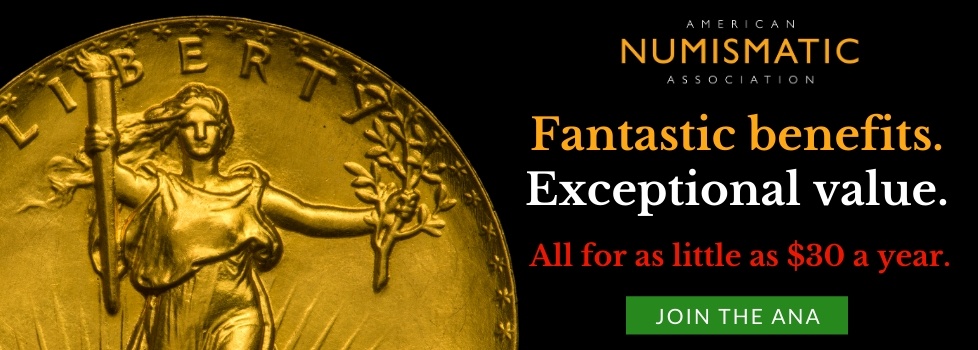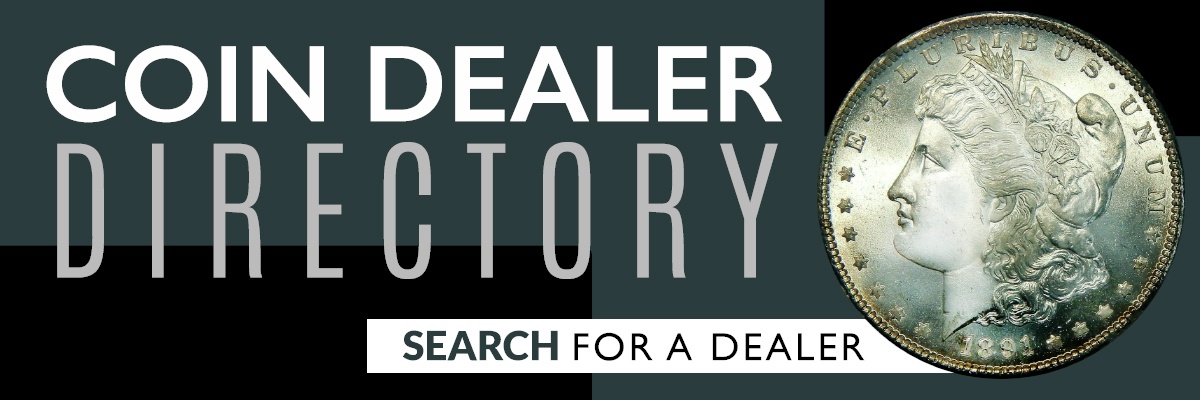George Washington: Gallant Revolutionary
Originally published in The Numismatist, February 2018
Bank notes of the antebellum period portray the Founding Father as a “gentleman warrior.”
Popular images of George Washington generally fall into two categories. The first type evolved from sentimental stories of a prayerful Washington at frigid Valley Forge or a young George chopping down a cherry tree in his father’s garden (“I cannot tell a lie, Pa”). These tales first appeared in Mason Locke Weems’ biography of the first president, originally published in 1800, continually expanded until 1809, and not out of print since. The Valley Forge legend became instantly popular and was recounted in Wilkins Tannehill’s Tales of the Revolution (1834); George Lippard’s Washington and His Men (1850); and the film Washington at Valley Forge (1908). More recently, President Ron ald Reagan, in his second Inaugural Address (1985), evoked the scene as an “[echo] of the past.” As apocryphal as these anecdotes are, they nevertheless contributed to the idealistic image of George Washington, the man.
A different view is epitomized by the fixed, changeless portrayal on America’s ubiquitous dollar bill. Gilbert Stuart’s iconic “Athenaeum” rendering, which predates Weems’ characterizations by more than a decade, forever enshrined the dignified restraint and aloofness of the nation’s first president. However, a third image—Washington as pugnacious warrior—is lesser known, even though it, too, entered the collective consciousness early on. Such interpretations were largely derived from paintings by John Trumbull, a veteran of the Continental Army who produced a number of portraits of General Washington, most notably The Capture of the Hessians at Trenton (December 26, 1776) and The Death of General Mercer at the Battle of Princeton (January 3, 1777). Even Gilbert Stuart, who produced the most unmilitary images of the president, depicted him as an impetuous man of action in Washington at Dorchester Heights (1806). The image of George Washington as a “gentleman warrior” (in the words of author Stephen Brumwell in his 2012 book of the same name) gained renewed popularity in the antebellum period. Such portrayals were celebrated in history, literature and the arts.
▲ John Trumbull, who painted THE CAPTURE OF THE HESSIANS AT TRENTON (pictured), influenced Washington’s depiction as a warrior. Photo: Wikipedia Commons / Yale University Art Gallery
Iconography on the paper money of the time followed suit. For instance, in 1841 the Monmouth Bank of Freehold in New Jersey issued $5 notes with a vignette of a uniformed General Washington on horseback, leading his troops into the Battle of Monmouth. The note’s design stressed the importance of the historic event: On June 28, 1778, the Continental Army, led by Washington, defeated the British troops under Sir Henry Clinton.
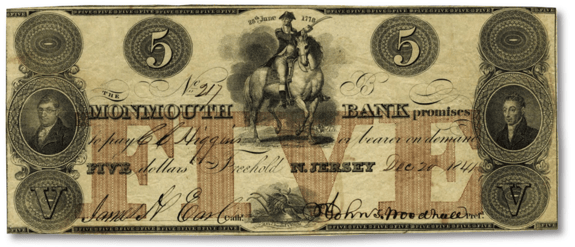
▲ Photo: National Numismatic Collection / Smithsonian Institute
According to George Wait, who wrote the authoritative reference on New Jersey currency, the portrait on the right side of the note shows the Marquis de Lafayette, one of Washington’s surrogate sons in his extended military family. Wait did not know the identity of the man at the left (nor does anyone else). Initially, the bills were released in denominations of $1, $2 and $5 in the 1820s, though with different portraits at the left and right. They also lacked the overprinted denomination, which was intended to discourage counterfeiting. (The 1841 note likely was the first to use the color red as a deterrent to forgers.)
Numerous currency notes of the antebellum era were aimed at promoting a common history and collective identity. Circulation of the bills bolstered regional and local pride, and encouraged their public acceptance at a time when paper money often was derided as “filthy rags.”

▲ GEORGE WASHINGTON is indeed the “gentleman warrior” in this Currier & Ives print. In the central vignette on a $5 New Jersey note (below), he strikes a militaristic pose in commemoration of the Battle of Monmouth. Photo: Library of Congress
Such historic memory dominates $100 notes from the 1830s, issued by the Delaware Bridge Company in Lambertville, New Jersey, which depict the Delaware River (seen in the distance) and Washington after the Battle of Trenton in 1776. The same motif appeared on $20 notes from the Bank of Illinois in Shawneetown in the 1840s. Also in the ’40s, $5 notes from the Berks County Bank in Reading, Pennsylvania, featured a version of Stuart’s Washington at Dorchester Heights at the right.
.png?width=600&name=deleware%20bridge%20company%20washington%20note%20(1).png)
▲ The Delaware Bridge Company issued this $100 note in the 1830s. Washington is shown in the vignette at top center after the Battle of Trenton. The Delaware River can be seen in the background. Photo: Heritage Auctions
In the late 1850s, the short-lived Northwestern Bank of Georgia in Ringgold came forth with $5 notes bearing a portrait of Washington at the right and a rendering of the Battle of Lexington at the upper left. Not surprisingly, the surrender of Cornwallis at Yorktown also appears on currency during the antebellum era, notably on $5 bills from the Bank of Chester in South Carolina. About the same time, the Stock Security Bank in Hackensack, New Jersey, issued $5 notes with Liberty and a minuteman flanking a medallion or plaque of America’s first president. And as late as 1863, on $5 notes from the Washington County Bank in Richmond, Rhode Island, the central vignette featured a cameo bust of Washington protected by Liberty. At the right, two Native Americans regard the portrait with awe; at the left, a Continental Army officer (possibly Washington) looks at the glorified image. The vignette probably was engraved by Toppan, Carpenter & Company and adapted from a drawing by F.O.C. Darley.
▲ A $5 NOTE from the short-lived Northwestern Bank of Georgia in Ringgold carries a portrait of Washington at the lower right and a vignette of the Battle of Lexington at the upper left. Photo: Heritage Auctions
These issues, and a good deal more, that depict warrior Washington in uniform on horseback or with sword drawn, were never completely replaced by those with decidedly unmilitary portraits of him, such as Stuart’s “Athenaeum” or “Lansdowne” renderings, even though they were readily embraced when they appeared. Nor did the sentimental image of a pious and virtuous George Washington completely overwhelm the warrior motif. Although republican virtues, civil moderation and Christian piety became important parts of the American consciousness, so did military zeal and political passion.
All considered, George Washington is the most widely featured American historical figure on paper money, as author Q. David Bowers has found. He also is “shown in many ways,” writes Bowers, with his portrait “within an ellipse or rectangle, his bust in the classic style, standing with a horse, standing alone, and in other poses.” (Andrew Jackson is perhaps second in popularity, but nearly always is presented as a portrait, not standing or in action.) Some notes even depict the “First Couple,” George and Martha. A particularly striking example is the $1 note issued by the George Washington Bank in Corning, New York, from the 1850s through the beginning of the Civil War. On the front, a medallion-like portrait of Martha Washington is held by two angels at top center, while her husband’s image (engraved by Alfred Jones) is at the bottom right. On the back, George Washington takes center stage, with the numeral “1” on either side, a reminder that he was the nation’s first president.
.png?width=571&name=bank%20of%20chester%20washnigton%20note%20(1).png)
▲ The Surrender of Cornwallis at Yorktown is represented on a $5 note from the Bank of Chester in South Carolina (top), while a $4 note issued by the Bank of Washington in North Carolina (bottom) features both George and Martha Washington. Photos: Heritage Auctions
Paper money in the antebellum South also displayed portraits of both George and Martha, including $4 notes from the Bank of Washington in Washington, North Carolina, which display the national coat of arms flanked by five allegorical figures. Another $4 note, this one from the Bank of the State of North Carolina, prominently bore a round portrait of George Washington at the left. In the 1850s, the Bank of Middle Georgia in Macon released $5 notes with an oval image of Washington flanked by two allegorical figures, one representing “Navigation,” the other “Agriculture.”
Starting in 1857, the Commercial Bank of Brunswick, Georgia, issued $2 notes with a central vignette of President Washington surmounted by a Heraldic Eagle and flanked by Liberty at the left and two other allegorical females at the right. Below, at the left, is an oval portrait of Thomas Jefferson. As for higher-denomination notes, in 1860 the Central Rail Road and Banking Company in Savannah, Georgia, emitted a $500 note with a dominant central vignette: a “Houdonesque” bust of George Washington behind the national coat of arms, flanked by three allegorical figures, one of whom is crowning the bust with a laurel wreath.
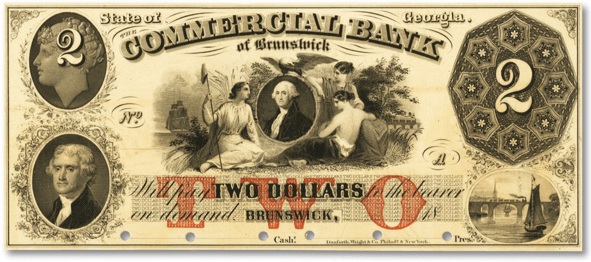
▲ A $2 BILL issued by the Commercial Bank of Brunswick in Georgia shows a portrait of Washington being regarded by Liberty and two other allegorical figures. Thomas Jefferson is pictured at the lower left. Photo: Heritage Auctions
Perhaps the most remarkable paper currency from the antebellum South is the $5 note issued by the Central Bank of Tennessee in the late 1850s. In the lower right corner, General Washington appears on horseback; in the opposite corner, a veteran is shown returning home, presumably from the war with Mexico. Washington’s outstretched arm gestures toward the homecoming scene, as if blessing the event. (Ten years later, the tableau would have been an apt pictorialization of the popular song “When Johnny Comes Marching Home.”)
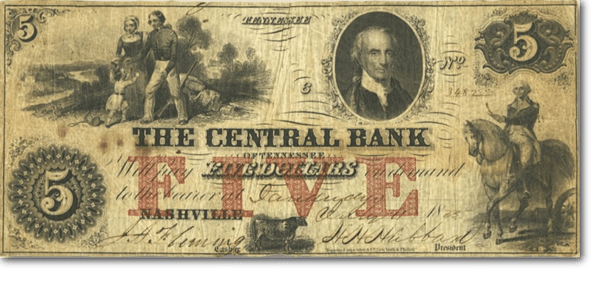
▲ A soldier’s homecoming is captured in the upper left vignette on this $5 note released by the Central Bank of Tennessee. General Washington, on horseback at the lower right, appears to bless the veteran’s return. The latter engraving was used on a variety of other notes, such as the $20 issued by the Planters Bank of Fairfield, South Carolina (below). Photos: Heritage Auctions
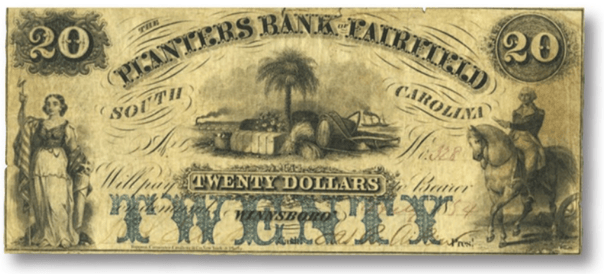
Washington’s benediction constituted a truly fatherly gesture, reinforcing the image of a man who considered the entire nation to be his “family.” But what kind of society would it be? In the North, the Mexican War was widely viewed as a pro-slavery swindle, with an eye toward expanding slave lands to the west. Texas, which had become a state in 1845, was a key arena in that battle. In Congress, a majority of representatives, Abraham Lincoln included, repeatedly voted to ban slavery in any territory snatched from Mexico. And Texas, as Matthew Karp argues in his recent book, This Vast Southern Empire: Slaveholders at the Helm of American Foreign Policy, “was above all a slaveholding republic” which, Southerners were convinced, “required U.S. support—and, if necessary, U.S. protection.”
Seen in this way, the picture of Washington on the Tennessee notes must have worked like a magic charm, bolstering the Southern view. On the bill, he is accompanied by a framed, slightly off-center portrait of Charles Carroll (1737-1832), Maryland’s delegate to the Continental Congress and one of the signers of the Declaration of Independence. The only Catholic present at the convention, Carroll also was a political outsider. He despised the Whiggish doctrines of parliamentarianism and majority rule. Instead, Carroll adhered to notions of checks and balances, as well as rules of moral behavior based on natural law (unchanging principles based on nature or God that define reality and mankind). Ideas of this kind came to 18th-century America through the writings of Viscount Bolingbroke and Sir Robert Filmer. They reached a new height of popularity in the antebellum South, partly because the South increasingly felt discriminated against by the majoritarian rule in Congress.
The Washington vignette was used on a number of notes from other banks (a $5 from the Atlanta Bank, a $20 from the Planters Bank of Fairfield, South Carolina, and a $50 from the Bank of Savannah, Georgia), but never as effectively as on the Tennessee notes. Except for the latter, none of these bear the homecoming scene or Carroll’s portrait. The impact of these two images should not be underestimated. They are indicative of the dramatic changes in visual representations of the nation—from E Pluribus Unum (“One Out of Many”) to the sectionalist presence of “the South.”
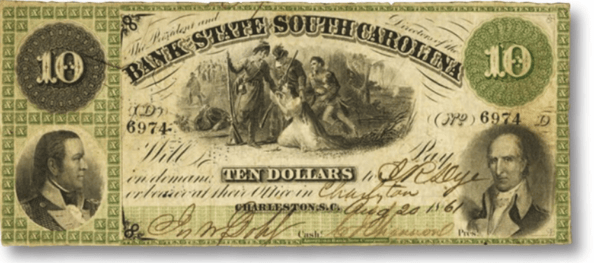
▲ The central vignette on this $10 note from the Bank of the State of South Carolina depicts the dramatic rescue of American prisoners toward the end of the Revolutionary War, with portraits of Generals Daniel Morgan (left) and Andrew Pickens (right). Photo: Heritage Auctions
Other “native sons” also made it onto paper money. Several bills carried portraits of George M. Troup, a former governor of Georgia and a leading advocate of states’ rights. Southern sectionalism became even more pronounced when former South Carolina Congressman and U.S. Vice President John C. Calhoun, a staunch defender of slavery, appeared on paper currency. He died in 1850, but his portrait, which was featured on notes issued throughout the entire South, sent a clear message across the Mason-Dixon Line.
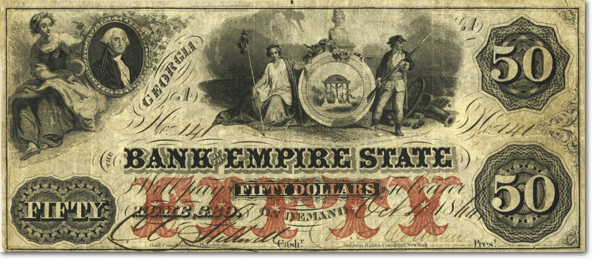
▲ A $50 note from the Bank of the Empire State in Rome, Georgia, shows a woman displaying Washington’s portrait at the top left, while the vignette at top center pictures Liberty and a vigilant soldier at either side of the state’s coat of arms. Photo: Heritage Auctions
The same can be said of $50 notes released by the Bank of the Empire State in Rome, Georgia. The bills show a seated woman at the left with a scythe and a portrait of Washington. The central vignette, however, pictures Liberty seated with a cap and pole, and a soldier standing with a rifle. Beside him is a shield bearing the state arms, surmounted by a bust. Perhaps even more powerful is the representation of “Southernness” on a $10 note issued by the Bank of the State of South Carolina in Charleston in 1861. The notes depict the dramatic rescue of American prisoners that took place in the state toward the end of the War of Independence, with portraits of two South Carolina generals—Daniel Morgan (left) and Andrew Pickens (right)—added for good measure. Ironically, the notes were produced by the New York-based American Bank Note Company, though the designs conveyed more than local patriotism. They portended the impending collapse of the Union and the coming of the Civil War. ■
SOURCES
Bowers, Q. David. Whitman Encyclopedia of Obsolete Paper Money, 9 volumes (to date). Atlanta: Whitman Publishing, 2014-. (ANA Library Catalog No. US75.B6a)
Doty, Richard. America’s Money, America’s Story, 2nd edition. Atlanta: Whitman, 2008. (GA40.D6)
Haxby, James A. Standard Catalog of United States Obsolete Bank Notes, 1782-1866. Iola, WI: Krause Publications, 2009. (US75.H3)
Karp, Matthew. This Vast Southern Empire: Slaveholders at the Helm of American Foreign Policy. Cambridge, MA: Harvard University Press, 2016.
McDermott, Scott. Charles Carroll of Carrolltown: Faithful Revolutionary. New York: Scepter, 2002.
Tschachler, Heinz. The Greenback: Paper Money and American Culture. Jefferson, NC & London: McFarland & Company, 2010. (US20.T7)
Wait, George. New Jersey’s Money. Newark, NJ: Newark Museum, 1976. (US80.N5W3)
Weems, Mason L. The Life of Washington. Marcus Cunliffe, ed. Cambridge, MA: Belknap Press of Harvard University Press, 1962.
About the American Numismatic Association
The American Numismatic Association is a nonprofit organization dedicated to educating and encouraging people to study and collect coins and related items. The Association serves the academic community, collectors and the general public with an interest in numismatics.
The ANA helps all people discover and explore the world of money through its vast array of educational programs including its museum, library, publications, conventions and numismatic seminars.

.jpg)
